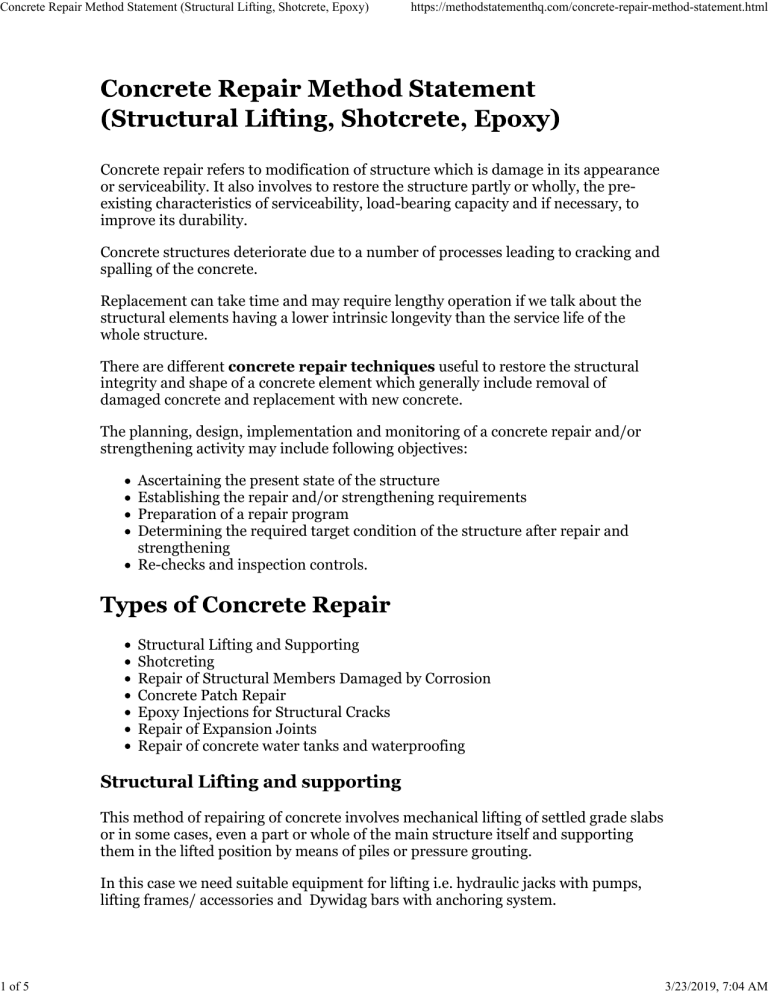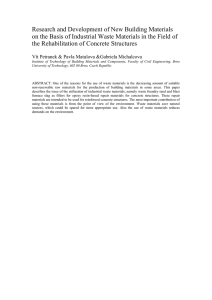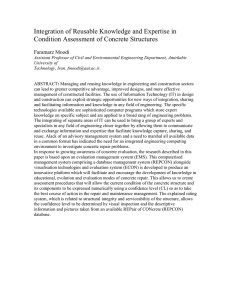
Concrete Repair Method Statement (Structural Lifting, Shotcrete, Epoxy) https://methodstatementhq.com/concrete-repair-method-statement.html Concrete repair refers to modification of structure which is damage in its appearance or serviceability. It also involves to restore the structure partly or wholly, the preexisting characteristics of serviceability, load-bearing capacity and if necessary, to improve its durability. Concrete structures deteriorate due to a number of processes leading to cracking and spalling of the concrete. Replacement can take time and may require lengthy operation if we talk about the structural elements having a lower intrinsic longevity than the service life of the whole structure. There are different concrete repair techniques useful to restore the structural integrity and shape of a concrete element which generally include removal of damaged concrete and replacement with new concrete. The planning, design, implementation and monitoring of a concrete repair and/or strengthening activity may include following objectives: Ascertaining the present state of the structure Establishing the repair and/or strengthening requirements Preparation of a repair program Determining the required target condition of the structure after repair and strengthening Re-checks and inspection controls. Structural Lifting and Supporting Shotcreting Repair of Structural Members Damaged by Corrosion Concrete Patch Repair Epoxy Injections for Structural Cracks Repair of Expansion Joints Repair of concrete water tanks and waterproofing Structural Lifting and supporting This method of repairing of concrete involves mechanical lifting of settled grade slabs or in some cases, even a part or whole of the main structure itself and supporting them in the lifted position by means of piles or pressure grouting. In this case we need suitable equipment for lifting i.e. hydraulic jacks with pumps, lifting frames/ accessories and Dywidag bars with anchoring system. 1 of 5 3/23/2019, 7:04 AM Concrete Repair Method Statement (Structural Lifting, Shotcrete, Epoxy) https://methodstatementhq.com/concrete-repair-method-statement.html The advantage of this concrete repair approach is that it does not require excavation. You can upgrade the grade slab’s capacities with minimum disruption, disruption to floor finishes is also minimal. Fast operation when we compare with all other available methods and finally cost effective in saving the structure. Method Statement for Structural Lifting and supporting Drill holes and construct the piles to suite the design load. Support the lifting frames on the constructed piles using temporary stools. Anchor the Dywidag bars to the slab to be lifted and connected the Dywidag bars to the lifting frame. Lift the frame against the constructed piles by means of hydraulic jacks in between them. The lifting of the frame will enable the slab also to be lifted, adjust the slab to the required level. Remove the jacks and lifting frame one by one, by connecting the lifted slab to the pile permanently. Shotcrete Concrete resurfacing & Repairing Shotcreting is another process of repairing the concrete. This method is useful if there is reinforcement corrosion or other deterioration. Also beneficial to strengthen any structural elements by a mixture of cement, aggregate and water, with or without admixtures. The mix is projected at high velocity from a nozzle in to place as a continuous stream without interruption. Compaction to produce a dense homogeneous mass is achieved by the mixture’s own velocity. Shotcreting method is useful for: concrete repair of large areas of concrete deteriorated due to reinforcement corrosion or other reasons, strengthening of existing concrete columns, beams and slabs by increasing the concrete sectional area by the application of shotcreting and by increasing the steel and construction of structures with complex shapes, where the preparation of shuttering is difficult and complex. 2 of 5 3/23/2019, 7:04 AM Concrete Repair Method Statement (Structural Lifting, Shotcrete, Epoxy) https://methodstatementhq.com/concrete-repair-method-statement.html Types of Shotcrete Repairing Dry Shotcrete Process In this method, the cement and aggregate are batched and mixed without added water, and fed into the delivery gun. The machine feeds a continuous and even amount of mixed material under high air pressure into a high velocity stream of dry air in the flexible delivery hose. Wet Shotcrete Process Water is introduced as a spray at a special nozzle at the discharge end. In wet process conventional concrete or grout pumping equipment is generally used. A suitable mix is pumped to the discharge nozzle along a flexible delivery hose. An additional air supply is introduced at the discharge nozzle, to speed up the flow and impart sufficient velocity so that the material is compacted on impact. Shotcrete Concrete Repair Method Statement Remove all distressed concrete from the affected structural area and a minimum of 20 mm behind the steel reinforcement. Sand blast substrate to remove loose concrete and to remove the corrosion in the steel. Reinforcement which has lost more than 15% of its cross sectional area shall be supplemented with new reinforcement. Protect the application area to avoid over spray. Apply the shotcrete, perpendicular to the substrate, ensuring full encapsulation of reinforcement and good bond with the substrate. You can leave the shotcreted surface as-shot or can form to a sem-smooth surface, as per the requirement. Most concrete repair works use aggregate of less than 5mm maximum size and type I cement. The aggregate cement ratio for a dry process is generally 3.5 : 4.0 : 1 by weight. The water : cement ratio in dry process is low (typically 0.38 to 0.41). The concrete placement characteristics are good density, low permeability, high strength (typically 30 to 40 N/mm2) and good bond to suitable substrate. Concrete Repair Method Statement using Epoxy The Project Manager has the overall responsibility for ensuring that all the concrete defects are complete in accordance with the specifications, manufacturer’s recommendations, Method Statement and Safety procedures. Construction Manager is responsible for execution of this work and to arrange all the materials, equipment and other requirements as necessary. Site Engineer to ensure that the responsible personnel are familiar with the method statement and safety requirements of the activity. Also to make sure that risk assessment is available on the project site before start of work. Site Engineer to ensure that the work force is familiar with the activity, hazards and mitigation effect 3 of 5 3/23/2019, 7:04 AM Concrete Repair Method Statement (Structural Lifting, Shotcrete, Epoxy) https://methodstatementhq.com/concrete-repair-method-statement.html of the situation. QC Engineer to inspect the work and ensure the compliance to the requirements / specifications. Project Safety Officer is responsible for ensuring that the activities are carried out as per the project specific safety regulations. Evaluation of all possible risks i.e. risk assessment and to ensure that all precautionary measures are in place prior to start the activity. He shall ensure the implementation of all necessary requirements regarding the health safety environment concerns. Site Foreman to ensure that the workers understand their duties and perform quality work in accordance with method statement and manufacturer’s recommendations. Equipment for Concrete Repairing Below is the list of equipment / tools mandatory for epoxy repairing / painting works: Paint Brushes/Roller Air Compressor Grinder Industrial Vacuum Machine Hand tools (Trowel, Spatula or Putty knife/scraper, hammer etc.) Step wise Method for Epoxy Concrete Repairing MasterBrace ADH 2200 is a non slumping epoxy bedding compound and adhesive. It is a two pack, fine aggregate filled, fast curing material, ideal for a variety of bedding, gap filling and concrete repair applications. MasterBrace ADH 2200 is a stiff but easily workable compound that can be applied by trowel, spatula or knife. It cures to give high mechanical properties typical of epoxy compounds. Its impact resistance and mechanical strength is greater than that of concrete. Apply the MasterBrace (concressive 2200) strictly in accordance with manufacturer’s recommendations and relevant applicable procedure. Store and place the material in a cool and dry place. Protect all the materials 4 of 5 3/23/2019, 7:04 AM Concrete Repair Method Statement (Structural Lifting, Shotcrete, Epoxy) https://methodstatementhq.com/concrete-repair-method-statement.html from direct sunlight and keep in safe place. Barricade the area under progress with this activity and provide necessary warning sign boards as per project safety plan. Cracks Repairing Method: Cracks occurs in substrate shall rout out, by chasing with chisel or grinder. After the surface preparation is complete, remove all the dust from the surface using an industrial vacuum machine. It is best practice to do vacuum cleaning before the start of each of the coat. Mixing: MasterBrace ADH 2200 (formerly known as CONCRESSIVE 2200) is available in two components. Mix component A and B together until you obtain a uniform streak free color. Application: By using a spatula, apply the mixed material into the routed out cracks, forcing the material into the concrete surface. Smooth off the surface and remove surplus material after application. To fill the blow holes etc. tight trowel the material into the prepared surface. Advantages High strength. Non-slump. Strong adhesion. Impact resistant Chemical resistant. Non shrink. Epoxy based. Trowels to a smooth finish. Easy to use. Supplied in pre-weighed units. No bonding agent or primer required. 5 of 5 3/23/2019, 7:04 AM


